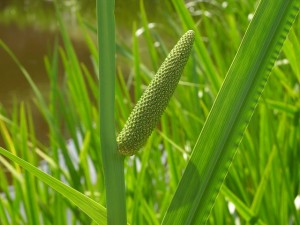Acorus calamus
Home " Latin species names " Acorus calamus
What is Acorus calamus?
Acorus calamus, known in Dutch as Kalmoes, is a well-known marsh plant or riparian plant, often used in a pond or as a helophyte filter. This is because calamus absorbs nutrients from the water very well. An excessive amount of nutrients can cause considerable algae growth, which we naturally want to avoid. While the Yellow Lis is known for its ability to remove nitrate, for phosphate you need calamus. Like all other helophytes, this riparian plant makes large root systems to extract as many nutrients as possible from the water.
Frequently asked questions
How to make a helophyte filter with Acorus Calamus?
Calamus, as mentioned, is often used in a so-called plant filter or helophyte filter. Such a filter involves pond water flowing past the roots. The extensive root systems of the helophytes harbour a huge number of bacteria. These bacteria break down the nutrients in the water so that the plants can use these dissolved nutrients for their growth. The bacteria have a symbiotic relationship with the helophytes. Installing a plant filter or helophyte filter ensures that too few nutrients remain for algae, preventing them from growing properly. A helophyte filter is also very suitable for use in swimming ponds or koi ponds, as not many plants are needed in the pond itself.
What is the plant height of Acorus Calamus?
Calamus can grow between 60 and 110 centimetres tall. Our winters are no problem for Calamus. In the Netherlands and Belgium, Calamus does not actually flower but a cob is formed.
Where can this plant be found?
This marsh plant can be found in the wild in many places in Europe. Especially along ditch banks and other large bodies of water where it has room to grow and develop. Originally from south-east Asia, it was brought to Europe long ago and spread this way.
Buy Acorus calamus?

Acorus Calamus is for sale from De Vijvermeester's webshop. Here you can find beautiful forests of high quality.
